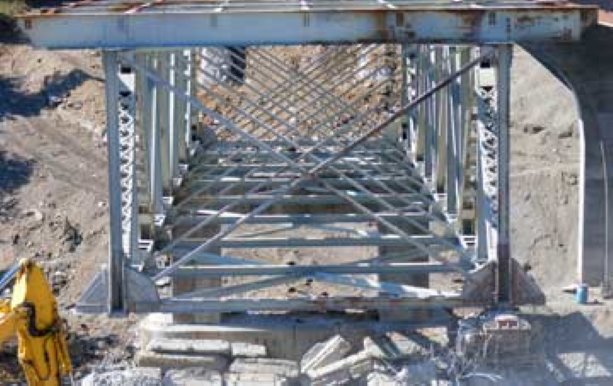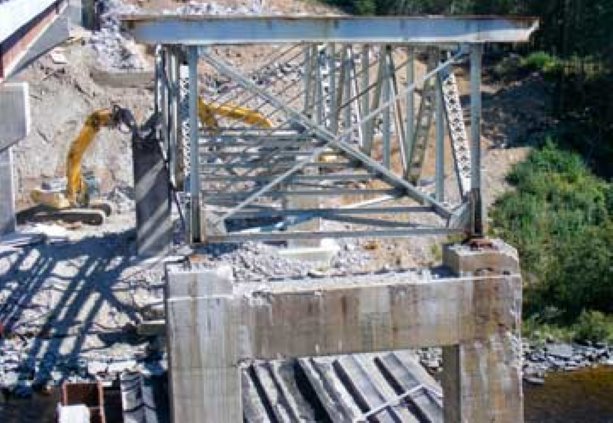Despite the logistics and huge distance from its Aurora-area headquarters in southern Ontario, Priestly Demolition has been busy demolishing three aging steel box-frame bridges in the far reaches of the province’s north.
In September, a small team of supervisors and equipment operators demolished the approximately 50-year-old Steel River Bridge on Highway 17 about 28 kilometres east of Terrace Bay.
From there the crew travelled northeast to Cochrane to demolish the 260-foot-span Wicklow River Bridge on Highway 11 just south of the town. In early November, it started taking down the 450-foot-long, five-span 63-year-old Frederick House Bridge which crosses the Frederick House River west of Cochrane.
There is an extra layer of complexity involved in demolishing bridges over rivers, says company president Ryan Priestly. “It’s a very complicated process. You have to protect the water 100 per cent. There can be no debris, no slurry, no anything in the water.”
Demolition is carefully sequenced. A steel beam platform is installed across the river and then covered with a geotech filter cloth to catch any material particularly the slurry created by the concrete saw cuts that might drop from the demolition activity on the bridge above, Priestly says.
The protective measures are spelled out in a plan that has to be approved by a design engineer and then a quality verification engineer and finally by the Ministry of Transportation, says Priestly. “If you don’t follow the plan to a T, there are significant penalties.”
And safeguarding environmental sensitive rivers isn’t the only challenge. Usually bridges being demolished, as is the case in the Terrace Bay and Cochrane ones, are immediately adjacent to the new bridges which have to be protected. As well, the crews often have to work in tight spaces hemmed in by deep embankments, he says.
For the northern Ontario crew, the back-to-back demolitions have meant working 12 to 13-hour days, at least on the Steel and Wicklow Bridge projects. With the advent of daylight savings time, those hours have been reduced somewhat on the Frederick House Bridge. “Safety always takes priority,” says superintendent Brian Priestly.
With winter just around the corner, however, there is a time-pressure deadline. The contractor is using five excavators (with hammer and shear attachments) compared to just three on the first two bridges. “We have also been fortunate the weather has been just above 0 (Celsius). There was apparently snow up here this time last year.”
On all three projects the crew members have been cognizant of the need to ensure their work doesn’t jeopardize the pristine rivers below. “Nobody takes that lightly.”
The Steel River at Highway 17 is a particularly sensitive rainbow trout area, while the other two rivers also are important fish habitat areas, says Ministry of Transportation media spokesperson Robin Perron.
All three bridges were in poor condition and have been replaced by new structures as stand-alone projects. The new $12-million Steel River Bridge consists of steel girders and a precast concrete deck and was opened to traffic in August. Carillion Canada Inc. was the general contractor.
Miller Paving was the general contractor for the two new Cochrane bridges. Completed and opened to traffic in October, the $12.5-million Frederick House River Bridge is a three-span, 160-metre-long bridge with a concrete deck on haunched steel girders. The same style of construction was used to erect the new $8.1-million Wicklow River Bridge which also opened the same month, says Perron.
Bridge construction and demolition in northern Ontario is especially daunting because of the shorter construction season, says Perron. “The northern climate is also a major contributing factor since most bridges require concrete staging.”
And bridge projects in the more remote areas of the North are even more challenging because material must be trucked in long distances from scattered concrete plants and steel mills. The availability of alternated detours is also quite limited, says Perron.
Nevertheless, Priestly Demolition considers those projects financially worthwhile and will continue to pursue them, says president Ryan Priestly. Not only has the company been expanding its fleet of specialized equipment during the past 10 years, “we’re one of the few (demolition) firms who are interested.”

Priestly Demolition supervisors and equipment operators demolished the approximately 50-year-old Steel River Bridge



Recent Comments
comments for this post are closed